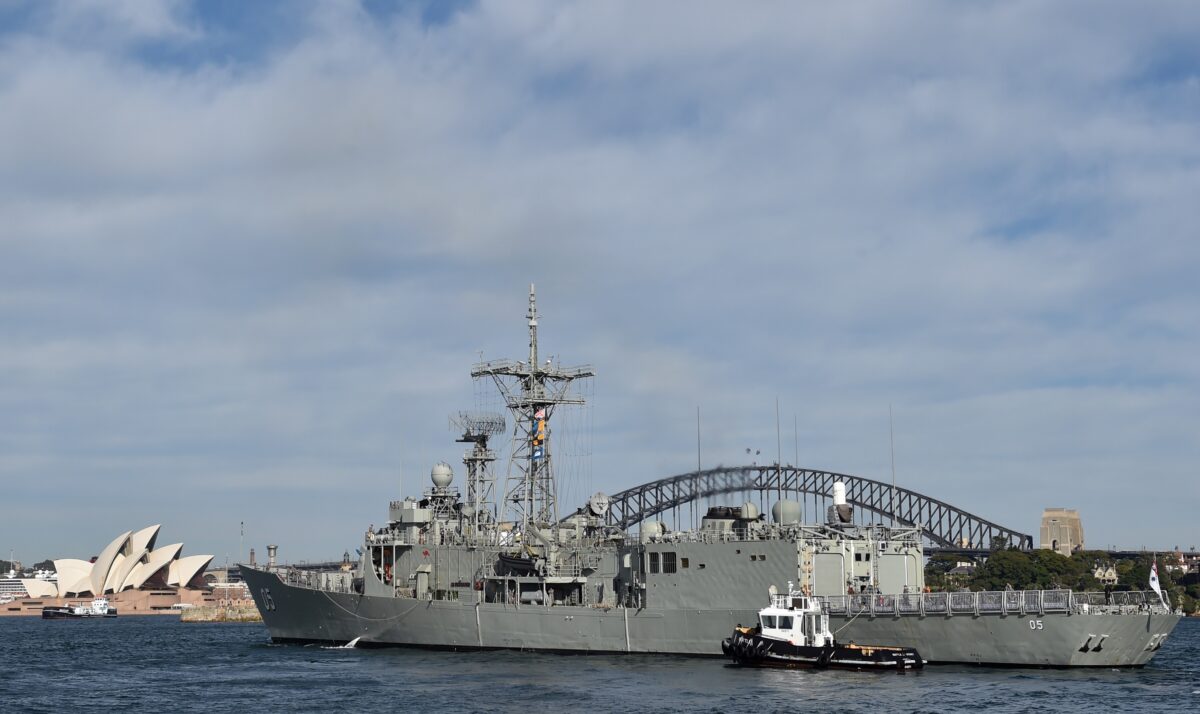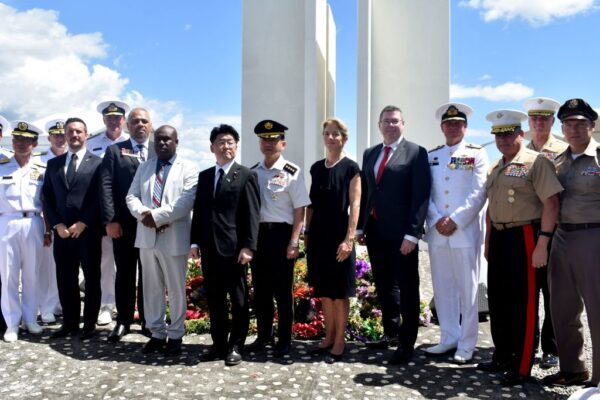AUKUS Readies for China and Beyond
Commentary The 2021 Australia-United Kingdom-United States (AUKUS) security treaty seems to be shaping the global architecture in the post-People’s Republic of China (PRC) era. More details of its shape and direction will be revealed at a Washington summit of the three leaders in the second half of March. There are many aspects still to resolve among the three partner states, which already have an unprecedented amount of cooperation in defense, intelligence, and political arenas, to a far greater degree than even NATO. And, unlike NATO, AUKUS is a global alliance with presence and capabilities already in the North and South Atlantic, the Mediterranean, the Indian Ocean, the North and South Pacific, and the two polar regions. The first steps to give a new muscularity to AUKUS will be how it approaches cooperation on second-tier strategic weapons capabilities, particularly engaging nuclear-powered submarines and longer-range power projection capabilities using manned and unmanned aircraft with hypersonic and other missile systems. AUKUS is, of necessity, equipping itself in defense terms for the longer path, which will take it beyond the probable life expectancy of China under the Chinese Communist Party (CCP). It is shaping itself for a world in which India, after the collapse of the PRC, could become a significant independent power asserting domination of Southeast Asia, the Indian Ocean, and the vital Suez and Cape of Good Hope sea routes, as well as Central Asia and the Middle East. Australia needs to arbitrate the strategic balance over the vital trade straits through Southeast Asia, and play a key role, as it does now, in patrolling the Arabian and Red seas. An AUKUS heads-of-state meeting in Washington, probably just after March 15, was expected to outline the shape of Australia’s acquisition of nuclear-powered submarines. Australia has made it clear it would commit the necessary funds—possibly up to A$100 billion (about $70 billion) to develop a domestic capability to build nuclear submarines. But that is a process that could take up to two decades, and Australia needs to upgrade its submarine capability before that, as its six existing Virginia-class submarines are decommissioned, even after a service life extension program (SLEP). Royal Australian Navy submarine HMAS Rankin is seen during AUSINDEX 21, a biennial maritime exercise between the Royal Australian Navy and the Indian Navy, in Darwin, Australia, on Sept. 5, 2021. (POIS Yuri Ramsey/Australian Defence Force via Getty Images) Public concerns at this time in the three member states reflect only the PRC threat to them, but AUKUS has built an alliance that goes beyond that. It took the core of the key “Five Eyes” accord—the UK-U.S. Accords on intelligence sharing between the United States, United Kingdom, Canada, Australia, and New Zealand—to create AUKUS, particularly given the pro-PRC dispositions of the Canadian and New Zealand governments. Both the Canadian Liberal Party minority government of Justin Trudeau and the New Zealand Labour Party government of Jacinda Ardern (who has already announced her retirement ahead of the October 2023 elections) are seen as moving away to probable conservative administrations, so their future role in AUKUS cannot be discounted. So the Washington summit was expected to be critical. As Bloomberg’s Kitty Donaldson reported, “Australia’s federal parliamentary schedule means [Prime Minister Anthony] Albanese could travel between March 10 and 19, while [UK Prime Minister Rishi] Sunak’s Government’s budget statement on March 15 [2023] means he is unlikely to leave the country immediately beforehand.” So just after March 16 seems a likely summit date. The summit was to have taken place after a visit to China by U.S. Secretary of State Antony Blinken, but Beijing’s mishandling of the “balloon crisis”—the overflight of the United States of a Chinese surveillance balloon—of early February obviated that, and President Joe Biden’s attempts to dampen down the growing U.S.-China crisis have been undermined. This is more to the disadvantage of China than to the United States. Australian Defense Minister Richard Marles, in Washington in early February, told the Australian Broadcasting Corporation, “I think what’s actually expected of us by both the U.S. and the UK is that we make a contribution to the net industrial base of the three countries, by developing the capacity in Australia to build a nuclear-powered submarine.” He was also there to push back against U.S. Sen. Jack Reed (D-R.I.) and former Sen. Jim Inhofe (R-Okla.), who had claimed that providing U.S. submarine technology and leasing U.S. Navy Virginia-class submarines to Australia would be highly detrimental to the U.S. strategic industrial capability. How would they feel about the loss of alliance partners as an alternative to adding to the combined alliance industrial base in nuclear submarine construction? The eventual Australian-built SSN was l

Commentary
The 2021 Australia-United Kingdom-United States (AUKUS) security treaty seems to be shaping the global architecture in the post-People’s Republic of China (PRC) era.
More details of its shape and direction will be revealed at a Washington summit of the three leaders in the second half of March.
There are many aspects still to resolve among the three partner states, which already have an unprecedented amount of cooperation in defense, intelligence, and political arenas, to a far greater degree than even NATO. And, unlike NATO, AUKUS is a global alliance with presence and capabilities already in the North and South Atlantic, the Mediterranean, the Indian Ocean, the North and South Pacific, and the two polar regions.
The first steps to give a new muscularity to AUKUS will be how it approaches cooperation on second-tier strategic weapons capabilities, particularly engaging nuclear-powered submarines and longer-range power projection capabilities using manned and unmanned aircraft with hypersonic and other missile systems.
AUKUS is, of necessity, equipping itself in defense terms for the longer path, which will take it beyond the probable life expectancy of China under the Chinese Communist Party (CCP). It is shaping itself for a world in which India, after the collapse of the PRC, could become a significant independent power asserting domination of Southeast Asia, the Indian Ocean, and the vital Suez and Cape of Good Hope sea routes, as well as Central Asia and the Middle East.
Australia needs to arbitrate the strategic balance over the vital trade straits through Southeast Asia, and play a key role, as it does now, in patrolling the Arabian and Red seas.
An AUKUS heads-of-state meeting in Washington, probably just after March 15, was expected to outline the shape of Australia’s acquisition of nuclear-powered submarines. Australia has made it clear it would commit the necessary funds—possibly up to A$100 billion (about $70 billion) to develop a domestic capability to build nuclear submarines. But that is a process that could take up to two decades, and Australia needs to upgrade its submarine capability before that, as its six existing Virginia-class submarines are decommissioned, even after a service life extension program (SLEP).

Public concerns at this time in the three member states reflect only the PRC threat to them, but AUKUS has built an alliance that goes beyond that. It took the core of the key “Five Eyes” accord—the UK-U.S. Accords on intelligence sharing between the United States, United Kingdom, Canada, Australia, and New Zealand—to create AUKUS, particularly given the pro-PRC dispositions of the Canadian and New Zealand governments. Both the Canadian Liberal Party minority government of Justin Trudeau and the New Zealand Labour Party government of Jacinda Ardern (who has already announced her retirement ahead of the October 2023 elections) are seen as moving away to probable conservative administrations, so their future role in AUKUS cannot be discounted.
So the Washington summit was expected to be critical. As Bloomberg’s Kitty Donaldson reported, “Australia’s federal parliamentary schedule means [Prime Minister Anthony] Albanese could travel between March 10 and 19, while [UK Prime Minister Rishi] Sunak’s Government’s budget statement on March 15 [2023] means he is unlikely to leave the country immediately beforehand.” So just after March 16 seems a likely summit date.
The summit was to have taken place after a visit to China by U.S. Secretary of State Antony Blinken, but Beijing’s mishandling of the “balloon crisis”—the overflight of the United States of a Chinese surveillance balloon—of early February obviated that, and President Joe Biden’s attempts to dampen down the growing U.S.-China crisis have been undermined. This is more to the disadvantage of China than to the United States.
Australian Defense Minister Richard Marles, in Washington in early February, told the Australian Broadcasting Corporation, “I think what’s actually expected of us by both the U.S. and the UK is that we make a contribution to the net industrial base of the three countries, by developing the capacity in Australia to build a nuclear-powered submarine.” He was also there to push back against U.S. Sen. Jack Reed (D-R.I.) and former Sen. Jim Inhofe (R-Okla.), who had claimed that providing U.S. submarine technology and leasing U.S. Navy Virginia-class submarines to Australia would be highly detrimental to the U.S. strategic industrial capability.
How would they feel about the loss of alliance partners as an alternative to adding to the combined alliance industrial base in nuclear submarine construction?
The eventual Australian-built SSN was likely to be a new design, drawing from U.S. and UK experience, but the interim leased vessels could only be U.S. Virginia-class SSNs (nuclear-powered attacked submarines). The UK has too few Astute-class boats to lease any to Australia.
Australian submariners are already training on Astute-class and Virginia-class submarines.
Australia’s retiring ambassador to the United States, Arthur Sinodinos, recently noted, “I think we can look forward in the first three or four months … to have more detail on pillar one, which is the submarines both in terms of the final pathway, if you like, as well as the interim capabilities building up to that.” He also said that the next phase of the challenge would be faced by his replacement, former Australian Prime Minister Kevin Rudd.
Meanwhile, Australia’s significant step toward moving from a capable middle power in the Indo-Pacific to a strategic global player has begun to take shape. Australia, in two world wars, and the Korean conflict, was able to project power globally as part of the UK and (later) U.S.-led coalitions. The UK was the major global power in 1880 when it had a population of only 34.6 million. Australia’s population today is 26,265,047 as of Feb. 4. Educational, structural, and technological factors have historically weighed more than sheer population numbers.

That is not to say that Australian defense procurement and local procurement have historically been efficient. Even the last great Labor Party defense push (under then-Defense Minister Kim Beazley, in 1986) was extremely inefficient in global terms, even though it reoriented Australia for the post-Cold War era. The cost of Australia’s Anzac-class frigates and Collins-class submarines was arguably double the global market cost. Earlier, Australia’s decision under the Liberal Party in 1963 to buy the U.S. General Dynamics F-111C strike fighter instead of the UK’s BAC TSR-2 (tactical strike and reconnaissance) aircraft proved extremely expensive and had major political ramifications for Australia, the United States, and the UK.
The F-111Cs were not delivered until 1973. The UK, meanwhile, canceled the far more advanced TSR-2, which it would not have done had Australia persisted with the Royal Australian Air Force’s selection of it. The TSR-2’s cancellation was the watershed period for the UK aerospace industry, leading to the cancellation of the follow-on fighter to the UK’s Hawker Siddeley Harrier vertical takeoff and landing fighter, and the subsequent decline of Britain’s civil airliner and military aircraft independence.
That was the start of a major U.S. push to subordinate all of its allies’ sovereign aerospace and strategic weapons capabilities to U.S. options in the name of standardization. But that cost the United States a globally (and allied) competitive strategic industrial base that had hitherto, because of that competition, led to lower unit costs for weapons systems and shorter and more innovative development timeframes. The U.S. Defense Department’s obsession (like that of the UK Ministry of Defense’s own preoccupation) with enforced mergers in the aerospace, aeroengine, and overall defense industry sectors led to extended delivery times, a massive multiplication of costs, and a constraint on innovation, all through the removal of private-sector competition.
Meanwhile, Australia’s new minister for Defense Industry Australia, Pat Conroy, clearly missed the lessons of all this, possibly at the insistence of senior Australian uniformed officials. Australian military leadership has traditionally shied away from the great industrial and design leadership of Australia’s defense industrial and aerospace community (remember that the Wright Brothers’ boxkite design came complete as a gift from Australian designer Lawrence Hargrave). The U.S. approach that “not invented here” is the basis for the rejection of foreign systems is reversed in Australia, where “invented here” is something that causes the Australian military to fear that which is invented locally.

Conroy on Feb. 2 indicated that he wanted to end a “counterproductive obsession” with quotas of local content for major military contracts as part of an overhaul of defense industry policy to meet the challenge of building nuclear-powered submarines (SSNs) and long-range missiles in Australia.
Once again, he was persuaded to push the line that subcontracting component work on foreign-controlled defense platforms would provide “plenty of work domestically,” missing the point that such a policy did nothing to protect the autonomy of Australian strategic decision-making.
The government was expected to receive within February the final version of the Defense Strategic Review conducted by former Labor Party Defense Minister Stephen Smith and former Australian Defense Force chief, Air Chief Marshal Sir Angus Houston, which was expected to recommend Australia build up its stockpiles of missiles, drones, and other long-range strike weapons.
This was to set the stage for the March 2023 AUKUS summit, and would include measures to avoid a “capability gap,” which was expected to have Australia lease older nuclear attack submarines from the United States. In late January, Defense Minister Richard Marles ruled out acquiring an interim conventionally-powered submarine (SSK). That meant that the SLEP for the Collins-class would need to begin immediately, even if the Royal Australian Navy (RAN) was to be able to acquire one or more early-model U.S. Virginia-class SSNs, which would in no way be able to fulfill the RAN’s mission requirements until a full fleet of SSNs could be obtained.
Marles and Conroy have been persuaded that “local content,” which provides jobs for local workers, was the primary goal of an indigenous defense industrial capability rather than providing a strong measure of strategic sovereignty. Certainly, because of the Australian Defense Department’s—and successive Liberal and Labor governments’—prevarication, there was no alternative but to see an 18- to 20-year wait for an Australian-built nuclear attack submarine.
The Australian SSN program will significantly skew the Australian defense budget, noting: “This will be the greatest nation-building effort this country’s ever seen, like the Snowy Mountains [post-World War II hydro-electric Scheme] will pale into insignificance in terms of the scale of this project, the technological challenges to be overcome.” Conroy confirmed to The Australian Financial Review that there would be an emphasis on long-range strike weapons to give the Defence Force “greater teeth,” declaring he was “evangelical” about developing a local missile industry capable of maintaining existing warheads, growing the inventory, “and eventually manufacturing them locally.”
But Australia once had all that capability, evolving from a defense industrial base built for World War I, when the UK essentially abandoned the newly-independent Australia and New Zealand as Britain fought for survival against Germany and its allies.
The same thing happened in World War II. At the end of each war, London (and then London and Washington) told Australia to forget about the potent capabilities they had created and to literally “go back to farming and mining.”
The Labor Albanese government in Australia inherited the nascent AUKUS treaty from the outgoing Liberal-led Coalition government of Scott Morrison, which it defeated in the May 2021 elections. Mr. Albanese, however, embraced AUKUS but not the confidence that Australia should be a peer in the tripartite accords.
This is the major weakness of AUKUS, and one which is hampering the technological and economic revival of Australia at a time when its major export market, China, is likely to significantly reduce its requirement for Australian minerals and agricultural products.
Views expressed in this article are the opinions of the author and do not necessarily reflect the views of The Epoch Times.












